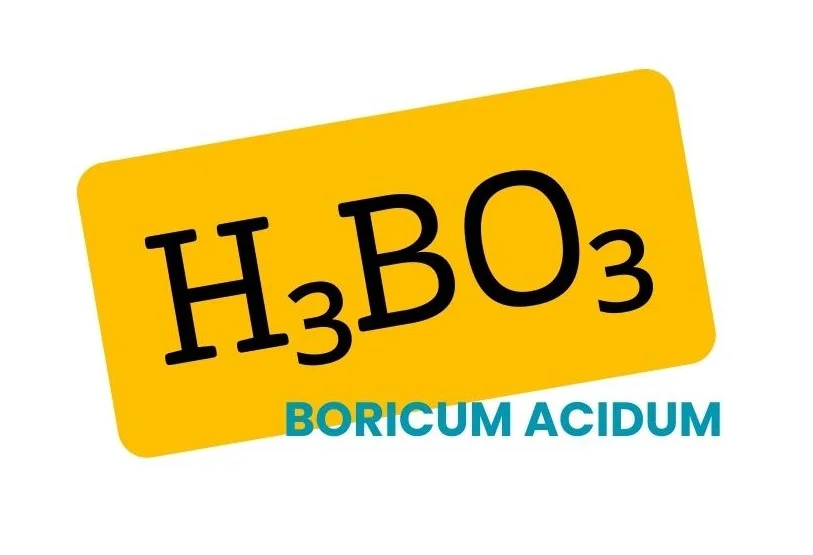Boric Acid, also known as Boricum Acidum, is a chemical compound used as an antiseptic disinfectant due to its ability to halt fermentation and putrefaction processes.
It is commonly employed in various medical applications, including treating urinary tract issues and certain skin conditions.

Table of Contents
ToggleSOURCE INFORMATION
Scientific Classification
- Chemical Formula: H₃BO₃
- Common Name: Boric Acid
- Other Names: Boracic Acid, Hydrogen Borate
Description: Boric acid, also known as boracic acid or hydrogen borate, is a weak, monobasic Lewis acid with antiseptic, antifungal, and mild astringent properties.
It occurs naturally in some minerals and has been used for various purposes, including as an antiseptic, insecticide, flame retardant, and in the manufacture of glass and ceramics.
Historical Use: Boric acid has a long history of use in traditional medicine, particularly as an antiseptic and eyewash.
Ancient civilizations such as the Greeks and Romans used borax, a salt of boric acid, for its cleansing and healing properties.
In the 19th century, boric acid became a popular household remedy for various ailments.
Homeopathic Preparation
- In homeopathy, Boricum Acidum is prepared using the process of potentization, which involves serial dilution and succussion (vigorous shaking).
- The resulting homeopathic remedy, Boric Acid, is believed to retain the energetic essence of the original substance while minimizing the presence of physical molecules.
Medicinal Properties in Homeopathy
Boricum Acidum is used as a homeopathic remedy with a range of therapeutic indications.
It is primarily associated with symptoms related to the mucous membranes, skin, eyes, and urinary tract.
Some key indications for Boricum Acidum in homeopathy include:
- Eye infections, conjunctivitis, and styes with discharge that is acrid, burning, and profuse.
- Ear infections, otitis externa, and eczema around the ears.
- Vaginal discharge with itching, burning, and inflammation, especially in cases of yeast infections (candidiasis).
- Skin conditions, including eczema, dermatitis, and fungal infections, with symptoms of burning, itching, and redness.
- Urinary tract infections (UTIs) with burning pain during urination and frequent, scanty urine.
Safety Considerations
- When used in homeopathic dilutions according to standard practices, Boricum Acidum is generally considered safe for most individuals, including infants, pregnant women, and the elderly.
- However, like all homeopathic remedies, it is important to use Boricum Acidum under the guidance of a qualified homeopathic practitioner to ensure proper dosage and administration.
Regulatory Status: Homeopathic remedies like Boricum Acidum are regulated as over-the-counter drugs in many countries, including the United States and Europe.
- They are available in various potencies and formulations, including liquid dilutions and lactose pellets.
DRUG PATHOGENESIS
- Boric Acid acts primarily on the urinary system and skin, exerting its effects through its antiseptic and astringent properties.
- It is known to alleviate pain in the region of the ureters and reduce frequent urination accompanied by burning and tenesmus.
- Additionally, it exhibits an influence on the female reproductive system, particularly during the climacteric period.
KEY CHARACTERISTICS
- Antiseptic and disinfectant properties.
- Relieves pain in the region of the ureters.
- Addresses symptoms of frequent urination with burning and tenesmus.
- Exhibits effects on the skin, including multiform erythema, oedema, and exfoliating dermatitis.
- Influences the female reproductive system, relieving climacteric flushings and addressing vaginal coldness.
DETAILED ORGAN SYMPTOMS
- Skin: Multiform erythema (redness) on the trunk and upper extremities, oedema (swelling) around the eyes, exfoliating dermatitis (skin shedding).
- Female: Climacteric flushings (hot flashes), sensation of coldness in the vagina, frequent urination with burning and tenesmus.
MODALITIES
- Symptoms worsen from coldness.
- Relief from antiseptic and disinfectant properties.
- Symptoms may be aggravated by heat or pressure.
RELATIONSHIP WITH OTHER DRUGS
- Boric Acid may complement the effects of other antiseptic agents in combination therapy.
- It may interact with certain medications or substances; caution is advised when using concurrently.
NON-HOMOEOPATHIC USES
These non-homeopathic uses of certain substances can be quite effective in treating various conditions:
Boracic Acid
- In chronic cystitis: Used as an injection.
- Ingestion: A teaspoonful mixed with a glass of hot milk, taken internally.
Boro-Glyceride (Boroglycerin)
- As a powerful antiseptic: Prepared as a solution (1/40).
- For external use: Diluted in water (15 grains to 1 oz.) to treat styes.
- As a dusting powder: Applied topically on ulcerated surfaces.
These uses demonstrate the versatility of these substances in addressing a range of medical conditions, from urinary tract infections like cystitis to topical infections like styes and ulcerated wounds.
However, it is important to use them under appropriate medical guidance and in the correct concentrations to ensure safety and efficacy.
DOSE
- Boric Acid is typically administered in the third trituration (a form of dilution and potentization used in homeopathy).
Frequently Asked Questions
What is Boric Acid used for?
- Boric Acid is used as an antiseptic disinfectant to halt fermentation and putrefaction.
- It is also employed in treating urinary tract issues and certain skin conditions.
Is Boric Acid safe to use?
- When used in appropriate concentrations and under medical guidance, Boric Acid is considered safe for its intended purposes.
- However, excessive, or improper use may lead to adverse effects, and caution should be exercised.
Can Boric Acid be used for skin conditions?
- Yes, Boric Acid can be effective in treating certain skin conditions such as erythema, oedema, and dermatitis.
- However, it should be used topically and according to medical advice.
Is Boric Acid suitable for vaginal use?
- Boric Acid has been used intravaginally for certain conditions, but its use should be guided by a healthcare professional to avoid potential complications.Top of Form
Meaning of Difficult Words
- Antiseptic: A substance that inhibits the growth of microorganisms and prevents infection.
- Putrefaction: The process of decay or decomposition, especially of organic matter.
- Ureter: The duct through which urine passes from the kidney to the bladder.
- Climacteric: The period in a woman’s life when hormonal changes occur, typically leading to menopause.
- Tenesmus: Painful, ineffective straining to empty the bowel or bladder.
- Erythema: Redness of the skin, typically due to inflammation or irritation.
- Exfoliating: Shedding or peeling off in thin layers, especially of skin.
This comprehensive drug picture provides an in-depth understanding of Boric Acid, including its uses, effects, and precautions.













Leave a Reply